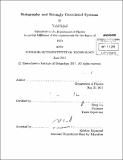| dc.contributor.advisor | Hong Liu. | en_US |
| dc.contributor.author | Iqbal, Nabil | en_US |
| dc.contributor.other | Massachusetts Institute of Technology. Dept. of Physics. | en_US |
| dc.date.accessioned | 2012-01-30T16:56:31Z | |
| dc.date.available | 2012-01-30T16:56:31Z | |
| dc.date.copyright | 2011 | en_US |
| dc.date.issued | 2011 | en_US |
| dc.identifier.uri | http://hdl.handle.net/1721.1/68873 | |
| dc.description | Thesis (Ph. D.)--Massachusetts Institute of Technology, Dept. of Physics, 2011. | en_US |
| dc.description | Cataloged from PDF version of thesis. | en_US |
| dc.description | Includes bibliographical references (p. 221-231). | en_US |
| dc.description.abstract | In this thesis we apply techniques arising from string theory - gauge-gravity/duality, or holography - to problems associated with strongly coupled quantum field theories under extreme conditions such as finite temperature or density. We first study a strongly coupled field theory at finite temperature. We demonstrate that its low frequency limit is determined by the horizon geometry of its gravity dual, i.e. by the "membrane paradigm" fluid of classical black hole mechanics. Thus generic boundary theory transport coefficients can be expressed in terms of geometric quantities evaluated at the horizon, providing a simple understanding of results such as the universality of the shear viscosity in theories with gravity duals. Away from the low frequency limit we find a nontrivial radial flow from the black hole horizon to the boundary of the spacetime; we derive equations governing this flow and demonstrate their use in the simple examples of charge and momentum diffusion. Next, we turn to the study of strongly coupled theories with a finite density of a U(1) charge. The near-horizon geometry of the gravity dual of such a state has an AdS 2 factor, indicating the existence of a nontrivial emergent conformal symmetry in the infrared with nontrivial scaling only in the time direction. We review earlier work indicating that fermionic perturbations of such a state reveal non-Fermi-liquid behavior, i.e. gapless fermionic excitations that are not those of Fermi liquid theory. We perform a one-loop calculation in the bulk to compute the contribution from these Fermi surfaces to the conductivity of the full system. Interestingly, within this class of non-Fermi liquids we find examples whose single-particle spectral function and transport behavior both resemble those of strange metals, i.e. the anomalous metallic state existing in the real-life high Tc cuprates above their superconducting transition temperature. In particular, for these examples the contribution to the conductivity is inversely proportional to temperature. In our treatment these properties can be understood as being controlled by the scaling dimension of the fermion operator in the emergent IR fixed point. We then turn to models of symmetry breaking in holographic models at finite density. We observe that the presence of the AdS₂ factor can result in the condensation of a neutral scalar operator. This can be used to model an "antiferromagnetic" phase in which a global SU(2) symmetry is broken down to U(1). We study the collective modes of the ordered phase and recover the expected spin waves from a gravitational treatment. We then note that the phase transition can be driven to zero temperature by tuning various bulk couplings, resulting in a quantum phase transition of the Berezinskii-Kosterlitz-Thouless type. We study this transition in detail, revealing novel critical behavior, including locally quantum critical dynamics and the existence of an infinite tower of excited states related by a discrete subgroup of the original emergent conformal symmetry. Throughout this thesis we focus on how the novel viewpoint provided by holography can help us gain new insights into the physics of strongly correlated systems. | en_US |
| dc.description.statementofresponsibility | by Nabil Iqbal. | en_US |
| dc.format.extent | 231 p. | en_US |
| dc.language.iso | eng | en_US |
| dc.publisher | Massachusetts Institute of Technology | en_US |
| dc.rights | M.I.T. theses are protected by
copyright. They may be viewed from this source for any purpose, but
reproduction or distribution in any format is prohibited without written
permission. See provided URL for inquiries about permission. | en_US |
| dc.rights.uri | http://dspace.mit.edu/handle/1721.1/7582 | en_US |
| dc.subject | Physics. | en_US |
| dc.title | Holography and strongly correlated systems | en_US |
| dc.type | Thesis | en_US |
| dc.description.degree | Ph.D. | en_US |
| dc.contributor.department | Massachusetts Institute of Technology. Department of Physics | |
| dc.identifier.oclc | 773279102 | en_US |
